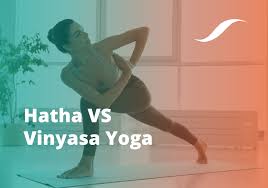Difference Between Hatha and Vinyasa Yoga

Different styles: Hatha is gentle, static; Vinyasa is flowing, dynamic.
Understanding Hatha Yoga
Hatha yoga, a traditional and inclusive practice rooted in ancient traditions, combines physical postures, pranayama (breathing techniques), and dhyana (meditation) to promote holistic well-being encompassing the physical, mental, and spiritual aspects of an individual.
This style of yoga emphasizes gentle, deliberate movements, mindful breath control, and holding asanas (poses) for a few breaths to enhance flexibility, core strength, and overall relaxation.
Particularly suitable for beginners, hatha yoga classes typically guide students through a series of asanas aimed at improving their mobility and equilibrium. In contrast to the dynamic and fluid movements of Vinyasa yoga, hatha yoga focuses on static poses to foster bodily awareness and tranquility.
Consequently, hatha yoga sessions are often characterized by a meditative and soothing atmosphere, making it an excellent choice for individuals seeking a gentle and therapeutic yoga practice.
By incorporating hatha yoga into their routine, practitioners can anticipate enhancements in their physical well-being, stress reduction, and the nurturing of a profound inner peace.
Exploring Vinyasa Yoga
In contrast to the holistic poses of Hatha yoga, Vinyasa yoga is a dynamic and flowing style of yoga that weaves together a series of poses with rhythmic breathing to create a continuous movement experience.
This style of yoga focuses on flowing sequences of poses linked with breath, creating a dynamic practice that challenges the body and mind.
Smooth shifts between postures guarantee a seamless flow, making Vinyasa yoga a faster-paced class compared to Hatha yoga.
As practitioners move through the poses, they experience improved balance, strength, and mental clarity. Vinyasa yoga also provides a cardiovascular workout, enhancing overall physical fitness.
The continuous movement experience in Vinyasa yoga helps build internal heat, increasing flexibility and detoxifying the body.
By linking poses with breath, Vinyasa yoga creates a meditative quality, quieting the mind and promoting a sense of calm.
With its dynamic and flowing sequences, Vinyasa yoga offers a unique yoga experience that cultivates physical, mental, and emotional well-being.
Vinyasa yoga can also be referred to as flow yoga, as it emphasizes continuous movement and breath synchronization throughout the practice.
Benefits of Each Style
What benefits can practitioners expect from each style of yoga? In the comparison of Hatha Yoga vs Vinyasa Yoga, the benefits are distinct yet complementary. Hatha Yoga is ideal for those seeking relaxation, stress reduction, and foundational strength.
It’s an excellent choice for beginners, as it focuses on holding postures for extended periods, promoting flexibility and calmness. On the other hand, Vinyasa Yoga offers a more dynamic practice, providing cardio fitness, strength training, and endurance benefits.
It’s perfect for those seeking a physical challenge and a fast-paced practice. Despite their differences, both styles share a common goal: to enhance overall physical and mental well-being.
Incorporating either Hatha or Vinyasa Yoga into their routine, practitioners can expect to feel more grounded, centered, and at peace.
Whether you’re looking to reduce stress, build strength, increase flexibility, improve balance, enhance mindfulness, or boost energy levels, both styles offer a unique set of benefits that cater to individual needs and goals.
Choosing the Right Fit
When deciding between Hatha and Vinyasa yoga, considering one’s fitness level and goals is crucial to finding a practice that aligns with their needs and preferences.
Choosing the right fit between Hatha and Vinyasa yoga depends on individual factors. Here are a few key considerations:
Fitness level: Hatha may be better suited for beginners, those seeking stress reduction, or individuals focusing on foundational strength, while Vinyasa is ideal for those seeking a more challenging workout or cardio and strength training.
Goals: Are you looking for relaxation and flexibility improvements with Hatha, or do you aim for a dynamic, flowing practice to enhance endurance and balance with Vinyasa?
Pace preference: Do you prefer a slower, more meditative pace with Hatha’s holding of poses, or are you drawn to a faster-paced, continuous flow of movements in Vinyasa?
Modified poses: Both styles offer modifications to accommodate various fitness levels and preferences, allowing for personalized adjustments and progression in practice.
Key Differences Revealed
Key differences between Hatha and Vinyasa yoga styles become apparent in their approaches to movement, breathing, and general practice goals.
Hatha yoga focuses on slow, deliberate movements, holding poses for longer periods to emphasize controlled breathing, relaxation, and central strength.
In contrast, Vinyasa yoga involves flowing from one pose to the next, linking movements with breath, and offers a fast-paced session with cardio and strength training benefits.
The poses and sequences in Hatha vs Vinyasa yoga styles also differ. Hatha yoga emphasizes physical postures, often holding them for extended periods, while Vinyasa yoga incorporates flowing movements, shifting between poses quickly. The benefits of Hatha yoga include increased central strength, flexibility, and relaxation, whereas Vinyasa yoga provides a cardio and strength training workout.
Ultimately, the choice between Hatha and Vinyasa yoga depends on individual preferences and fitness levels. Both styles cater to different needs, providing unique benefits for practitioners.
By understanding the key differences between these two popular yoga styles, individuals can choose the practice that best suits their goals and preferences, ensuring a more fulfilling and effective yoga experience.

 Smile Brighter: Meet Canberra’s Top Dental Hygienists
Smile Brighter: Meet Canberra’s Top Dental Hygienists  Transform Your Comfort: Discover the Benefits of Cushions Lab Seat Cushions and Pillows
Transform Your Comfort: Discover the Benefits of Cushions Lab Seat Cushions and Pillows  Enhance Your Mental Clarity with Modafresh 200
Enhance Your Mental Clarity with Modafresh 200  List of Top 10 Neurologists in India 2024
List of Top 10 Neurologists in India 2024  Body Care Products Manufacturers: Providing Quality Products for Your Skincare Needs
Body Care Products Manufacturers: Providing Quality Products for Your Skincare Needs  The Journey to the Best Microblading in Dubai: A Client’s Perspective
The Journey to the Best Microblading in Dubai: A Client’s Perspective  Exploring London’s Best Butcher Shops
Exploring London’s Best Butcher Shops  Enhance Your Shop Appeal with Sydney’s Best Carpentry Services
Enhance Your Shop Appeal with Sydney’s Best Carpentry Services  A Detailed Look at the Features of the LEGO Technic Mars Crew Exploration Rover
A Detailed Look at the Features of the LEGO Technic Mars Crew Exploration Rover